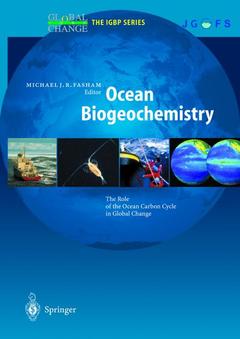Acknowledgements.- References.- 1 Biogeochemical Provinces: Towards a JGOFS Synthesis.- 1.1 Plankton Community Structure and Distribution.- 1.2 Partitioning the Oceans.- 1.3 Primary Production in Ocean Domains and Provinces.- 1.4 Bacterial Production and DOC Flux.- 1.5 A Provincial Outlook.- Acknowledgements.- References.- 2 Physical Transport of Nutrients and the Maintenance of Biological Production.- 2.1 Introduction.- 2.2 Global Overturning Circulation and Nutrient Transport.- 2.3 Convection.- 2.4 Wind-Driven Circulations: Gyres and Boundary Currents.- 2.5 Smaller-Scale Circulations: Mesoscale Eddies, Waves and Sub-Mesoscale Fronts.- 2.6 Interannual and Long-Term Variability.- 2.7 Conclusions.- Acknowledgements.- Notes.- References.- 3 Continental Margin Exchanges.- 3.1 Introduction.- 3.2 Recycling Systems.- 3.3 Export Systems.- 3.4 Coastal Upwelling Systems.- 3.5 California Current System.- 3.6 Humboldt Current System.- 3.7 Benguela Current System.- 3.8 Monsoonal Upwelling Systems.- 3.9 Biogeochemical Budgeting.- 3.10 The Arctic Shelves.- 3.11 Marginal Seas.- Acknowledgments.- References.- Apendix 3.1 — Continental Margins: Site Descriptions.- 4 Phytoplankton and Their Role in Primary, New, and Export Production.- 4.1 Introduction.- 4.2 Synthesis.- References.- 5 Carbon Dioxide Fluxes in the Global Ocean.- 5.1 Introduction.- 5.2 The Oceans’ Influence on Atmospheric CO2.- 5.3 How Big is the Global Ocean Sink?.- 5.4 What Processes Control Air-Sea CO2 Flux?.- 5.5 Variability in the CO2 Signal.- 5.6 The Gas Transfer Velocity.- 5.7 Conclusion: the Next Ten Years.- Acknowledgements.- References.- 6 Water Column Biogeochemistry below the Euphotic Zone.- 6.1 Introduction.- 6.2 The Twilight Zone: Biology, Biogeochemical Processes and Fluxes.- 6.3 The Fluxes of BiogenicMatter versus Depth.- 6.4 The Variable Composition of the World Ocean Waters along the Conveyor Belt.- 6.5 Conclusions and Perspectives.- References.- 7 The Impact of Climate Change and Feedback Processes on the Ocean Carbon Cycle.- 7.1 Introduction.- 7.2 Feedbacks.- 7.3 What do Current Models Predict?.- 7.4 Status of Our Understanding of Feedbacks.- 7.5 Nutrient Dynamics.- 7.6 Phytoplankton and Carbon Limitation.- 7.7 The Calcifiers.- 7.8 Iron Supply to the Oceans.- 7.9 Dimethyl Sulphide and the Biota.- 7.10 UV-B and Ozone Depletion.- 7.11 Summary of Biotic Feedbacks.- 7.12 Climate — Variability versus Change.- 7.13 Modeling — Future Goals.- 7.14 The Future.- 7.15 Summary.- Acknowledgements.- References.- 8 Benthic Processes and the Burial of Carbon.- 8.1 Introduction.- 8.2 Processes of Transport and Turnover of Material in the Deep Ocean.- 8.3 Quantitative Estimates of Carbon Deposition and Carbon Turnover.- 8.4 Proxy Indicators of Paleoproductivity.- 8.5 Conclusions.- References.- 9 Global Ocean Carbon Cycle Modeling.- 9.1 Introduction.- 9.2 Anthropogenic Carbon Uptake, Transient Tracers, and Physics.- 9.3 Global Biogeochemical Cycles.- 9.4 Ecosystem Dynamics.- 9.5 Other Topics.- 9.6 Summary.- Acknowledgements.- References.- 10 Temporal Studies of Biogeochemical Processes Determined from Ocean Time-Series Observations During the JGOFS Era.- 10.1 Introduction.- 10.2 The Oceanic Carbon Cycle and the Biological Carbon Pump.- 10.3 Global Inventory of JGOFS Time-Series Programs.- 10.4 Some Practical Lessons Learned from the JGOFS Time-Series Programs.- 10.5 Cross Ecosystem Habitat Comparisons: Nutrient, Chlorophyll and Production-Export Relationships.- 10.6 Beyond JGOFS: a Prospectus.- Acknowledgements.- References.- 11 JGOFS: a Retrospective View.- 11.1 The JGOFSScience Plan.- 11.2 The Process Studies.- 11.3 Iron Fertilisation Experiments.- 11.4 The Time Series Stations.- 11.5 The Global Survey.- 11.6 Remote Sensing.- 11.7 Benthic Studies.- 11.8 Continental Margins.- 11.9 Data Archiving.- 11.10 Models and Synthesis.- 11.11 Overall Conclusions.- References.





